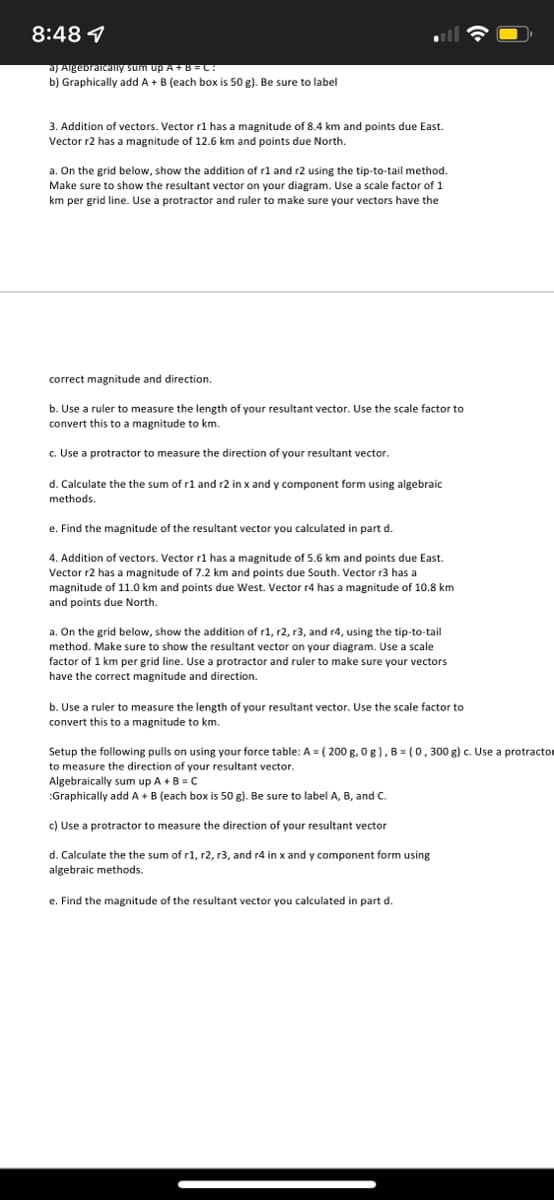3. Addition of vectors. Vector r1 has a magnitude of 8.4 km and points due East. Vector r2 has a magnitude of 12.6 km and points due North. a. On the grid below, show the addition of r1 and r2 using the tip-to-tail method. Make sure to show the resultant vector on your diagram. Use a scale factor of 1 km per grid line. Use a protractor and ruler to make sure your vectors have the correct magnitude and direction. b. Use a ruler to measure the length of your resultant vector. Use the scale factor to convert this to a magnitude to km. c. Use a protractor to measure the direction of your resultant vector. d. Calculate the the sum of r1 and r2 in x and y component form using algebraic methods.
3. Addition of vectors. Vector r1 has a magnitude of 8.4 km and points due East. Vector r2 has a magnitude of 12.6 km and points due North. a. On the grid below, show the addition of r1 and r2 using the tip-to-tail method. Make sure to show the resultant vector on your diagram. Use a scale factor of 1 km per grid line. Use a protractor and ruler to make sure your vectors have the correct magnitude and direction. b. Use a ruler to measure the length of your resultant vector. Use the scale factor to convert this to a magnitude to km. c. Use a protractor to measure the direction of your resultant vector. d. Calculate the the sum of r1 and r2 in x and y component form using algebraic methods.
Physics for Scientists and Engineers, Technology Update (No access codes included)
9th Edition
ISBN:9781305116399
Author:Raymond A. Serway, John W. Jewett
Publisher:Raymond A. Serway, John W. Jewett
Chapter11: Angular Momentum
Section: Chapter Questions
Problem 11.3OQ: Let us name three perpendicular directions as right, up, and toward you as you might name them when...
Related questions
Question

Transcribed Image Text:8:48 4
a) Algebraically sum up A+B=C!
b) Graphically add A + B (each box is 50 g). Be sure to label
3. Addition of vectors. Vector r1 has a magnitude of 8.4 km and points due East.
Vector r2 has a magnitude of 12.6 km and points due North.
a. On the grid below, show the addition of r1 and r2 using the tip-to-tail method.
Make sure to show the resultant vector on your diagram. Use a scale factor of 1
km per grid line. Use a protractor and ruler to make sure your vectors have the
correct magnitude and direction.
b. Use a ruler to measure the length of your resultant vector. Use the scale factor to
convert this to a magnitude to km.
c. Use a protractor to measure the direction of your resultant vector.
d. Calculate the the sum of r1 and r2 in x and y component form using algebraic
methods.
e. Find the magnitude of the resultant vector you calculated in part d.
4. Addition of vectors. Vector r1 has a magnitude of 5.6 km and points due East.
Vector r2 has a magnitude of 7.2 km and points due South. Vector r3 has a
magnitude of 11.0 km and points due West. Vector r4 has a magnitude of 10.8 km
and points due North.
a. On the grid below, show the addition of r1, r2, r3, and r4, using the tip-to-tail
method. Make sure to show the resultant vector on your diagram. Use a scale
factor of 1 km per grid line. Use a protractor and ruler to make sure your vectors
have the correct magnitude and direction.
b. Use a ruler to measure the length of your resultant vector. Use the scale factor to
convert this to a magnitude to km.
Setup the following pulls on using your force table: A = ( 200 g, 0 g), B = (0, 300 g) c. Use a protractor
to measure the direction of your resultant vector.
Algebraically sum up A + B = C
:Graphically add A + B (each box is 50 g). Be sure to label A, B, and C.
c) Use a protractor to measure the direction of your resultant vector
d. Calculate the the sum of r1, r2, r3, and r4 in x and y component form using
algebraic methods.
e. Find the magnitude of the resultant vector you calculated in part d.
Expert Solution
This question has been solved!
Explore an expertly crafted, step-by-step solution for a thorough understanding of key concepts.
Step by step
Solved in 5 steps with 2 images

Knowledge Booster
Learn more about
Need a deep-dive on the concept behind this application? Look no further. Learn more about this topic, physics and related others by exploring similar questions and additional content below.Recommended textbooks for you

Physics for Scientists and Engineers, Technology …
Physics
ISBN:
9781305116399
Author:
Raymond A. Serway, John W. Jewett
Publisher:
Cengage Learning

Physics for Scientists and Engineers: Foundations…
Physics
ISBN:
9781133939146
Author:
Katz, Debora M.
Publisher:
Cengage Learning

Physics for Scientists and Engineers with Modern …
Physics
ISBN:
9781337553292
Author:
Raymond A. Serway, John W. Jewett
Publisher:
Cengage Learning

Physics for Scientists and Engineers, Technology …
Physics
ISBN:
9781305116399
Author:
Raymond A. Serway, John W. Jewett
Publisher:
Cengage Learning

Physics for Scientists and Engineers: Foundations…
Physics
ISBN:
9781133939146
Author:
Katz, Debora M.
Publisher:
Cengage Learning

Physics for Scientists and Engineers with Modern …
Physics
ISBN:
9781337553292
Author:
Raymond A. Serway, John W. Jewett
Publisher:
Cengage Learning

Physics for Scientists and Engineers
Physics
ISBN:
9781337553278
Author:
Raymond A. Serway, John W. Jewett
Publisher:
Cengage Learning